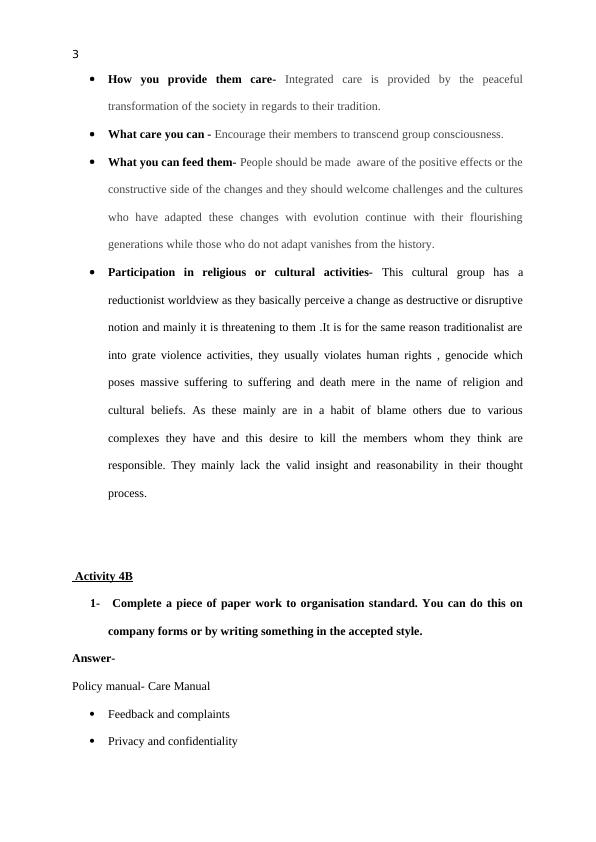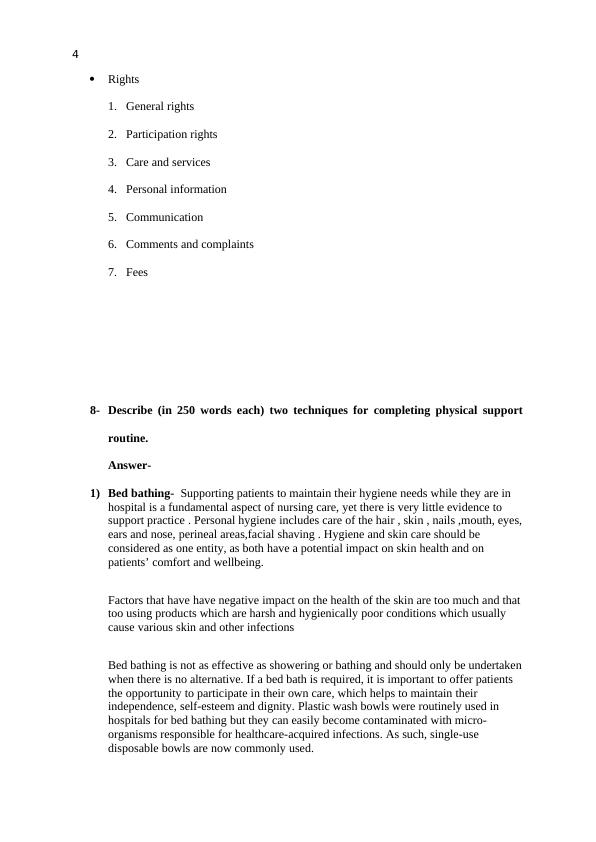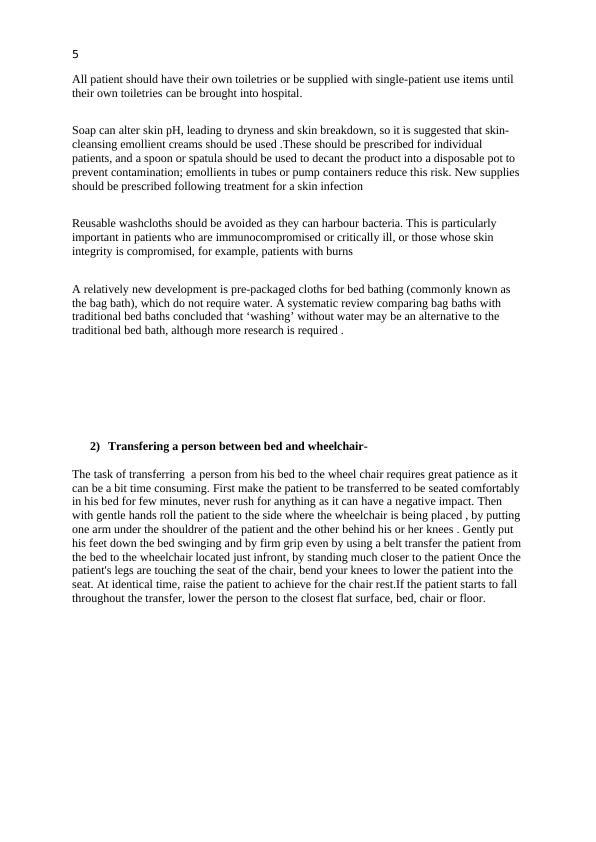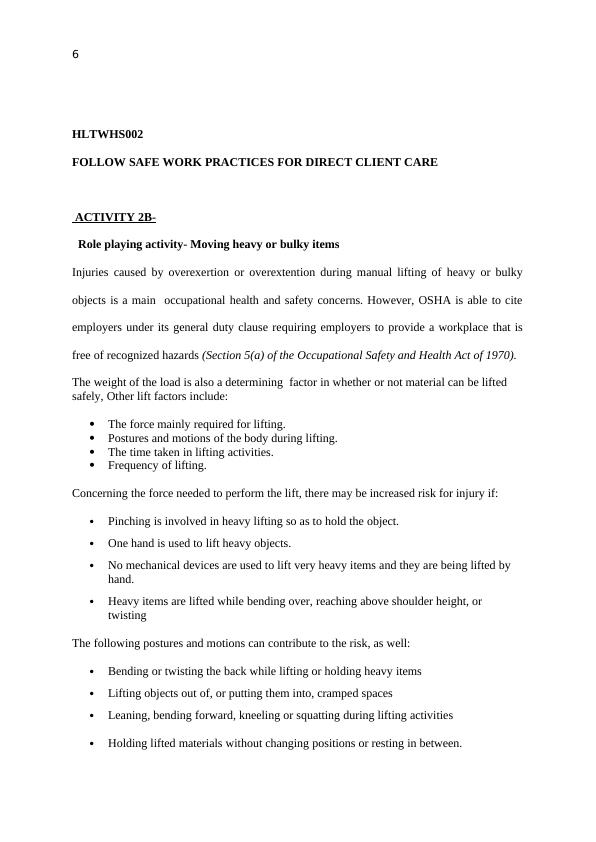Aged care- certificate 3 individual support age
Added on 2022-11-26
26 Pages5484 Words463 Views
1
Aged care- certificate 3 individual support age
Aged care- certificate 3 individual support age

2
CHCCCS011 - Meet personal support needs
Activity 1B
Ques 2- Identify a process that you are not qualified or trained to do.
Answer- Disability induction programme
What are the worst-case scenarios for-?
You – Not able to work with efficiency in today’s disability sector.
The client- Not able to provide person cantered approach
The organization- Lacks comprehensive grounding in this particular sector.
Identify a piece of equipment that you are not qualified or trained to use.
Answer- Portable oxygen tank
What are the worst-case scenarios for-?
You- Inefficient, as not able to deliver the right service at the right time.
The client- The problem or disease or situation will not be cured or even it sometimes
proves fatal.
The organization- lacks proficiency and sometimes needs to pay legally
Activity 1D
Identify a cultural group- Conventional corporate culture, The Traditionalist
How you act and conduct yourself around them- There are various lifestyle
changes created by new technologies and social institutions. Traditionalists are more
likely to resist these changes. So, one should act peacefully
How you speak and communicate with them- Speak confidently and at the same
time sound a little more mature and reasonable in putting forward anything to them.
CHCCCS011 - Meet personal support needs
Activity 1B
Ques 2- Identify a process that you are not qualified or trained to do.
Answer- Disability induction programme
What are the worst-case scenarios for-?
You – Not able to work with efficiency in today’s disability sector.
The client- Not able to provide person cantered approach
The organization- Lacks comprehensive grounding in this particular sector.
Identify a piece of equipment that you are not qualified or trained to use.
Answer- Portable oxygen tank
What are the worst-case scenarios for-?
You- Inefficient, as not able to deliver the right service at the right time.
The client- The problem or disease or situation will not be cured or even it sometimes
proves fatal.
The organization- lacks proficiency and sometimes needs to pay legally
Activity 1D
Identify a cultural group- Conventional corporate culture, The Traditionalist
How you act and conduct yourself around them- There are various lifestyle
changes created by new technologies and social institutions. Traditionalists are more
likely to resist these changes. So, one should act peacefully
How you speak and communicate with them- Speak confidently and at the same
time sound a little more mature and reasonable in putting forward anything to them.

3
How you provide them care- Integrated care is provided by the peaceful
transformation of the society in regards to their tradition.
What care you can - Encourage their members to transcend group consciousness.
What you can feed them- People should be made aware of the positive effects or the
constructive side of the changes and they should welcome challenges and the cultures
who have adapted these changes with evolution continue with their flourishing
generations while those who do not adapt vanishes from the history.
Participation in religious or cultural activities- This cultural group has a
reductionist worldview as they basically perceive a change as destructive or disruptive
notion and mainly it is threatening to them .It is for the same reason traditionalist are
into grate violence activities, they usually violates human rights , genocide which
poses massive suffering to suffering and death mere in the name of religion and
cultural beliefs. As these mainly are in a habit of blame others due to various
complexes they have and this desire to kill the members whom they think are
responsible. They mainly lack the valid insight and reasonability in their thought
process.
Activity 4B
1- Complete a piece of paper work to organisation standard. You can do this on
company forms or by writing something in the accepted style.
Answer-
Policy manual- Care Manual
Feedback and complaints
Privacy and confidentiality
How you provide them care- Integrated care is provided by the peaceful
transformation of the society in regards to their tradition.
What care you can - Encourage their members to transcend group consciousness.
What you can feed them- People should be made aware of the positive effects or the
constructive side of the changes and they should welcome challenges and the cultures
who have adapted these changes with evolution continue with their flourishing
generations while those who do not adapt vanishes from the history.
Participation in religious or cultural activities- This cultural group has a
reductionist worldview as they basically perceive a change as destructive or disruptive
notion and mainly it is threatening to them .It is for the same reason traditionalist are
into grate violence activities, they usually violates human rights , genocide which
poses massive suffering to suffering and death mere in the name of religion and
cultural beliefs. As these mainly are in a habit of blame others due to various
complexes they have and this desire to kill the members whom they think are
responsible. They mainly lack the valid insight and reasonability in their thought
process.
Activity 4B
1- Complete a piece of paper work to organisation standard. You can do this on
company forms or by writing something in the accepted style.
Answer-
Policy manual- Care Manual
Feedback and complaints
Privacy and confidentiality

4
Rights
1. General rights
2. Participation rights
3. Care and services
4. Personal information
5. Communication
6. Comments and complaints
7. Fees
8- Describe (in 250 words each) two techniques for completing physical support
routine.
Answer-
1) Bed bathing- Supporting patients to maintain their hygiene needs while they are in
hospital is a fundamental aspect of nursing care, yet there is very little evidence to
support practice . Personal hygiene includes care of the hair , skin , nails ,mouth, eyes,
ears and nose, perineal areas,facial shaving . Hygiene and skin care should be
considered as one entity, as both have a potential impact on skin health and on
patients’ comfort and wellbeing.
Factors that have have negative impact on the health of the skin are too much and that
too using products which are harsh and hygienically poor conditions which usually
cause various skin and other infections
Bed bathing is not as effective as showering or bathing and should only be undertaken
when there is no alternative. If a bed bath is required, it is important to offer patients
the opportunity to participate in their own care, which helps to maintain their
independence, self-esteem and dignity. Plastic wash bowls were routinely used in
hospitals for bed bathing but they can easily become contaminated with micro-
organisms responsible for healthcare-acquired infections. As such, single-use
disposable bowls are now commonly used.
Rights
1. General rights
2. Participation rights
3. Care and services
4. Personal information
5. Communication
6. Comments and complaints
7. Fees
8- Describe (in 250 words each) two techniques for completing physical support
routine.
Answer-
1) Bed bathing- Supporting patients to maintain their hygiene needs while they are in
hospital is a fundamental aspect of nursing care, yet there is very little evidence to
support practice . Personal hygiene includes care of the hair , skin , nails ,mouth, eyes,
ears and nose, perineal areas,facial shaving . Hygiene and skin care should be
considered as one entity, as both have a potential impact on skin health and on
patients’ comfort and wellbeing.
Factors that have have negative impact on the health of the skin are too much and that
too using products which are harsh and hygienically poor conditions which usually
cause various skin and other infections
Bed bathing is not as effective as showering or bathing and should only be undertaken
when there is no alternative. If a bed bath is required, it is important to offer patients
the opportunity to participate in their own care, which helps to maintain their
independence, self-esteem and dignity. Plastic wash bowls were routinely used in
hospitals for bed bathing but they can easily become contaminated with micro-
organisms responsible for healthcare-acquired infections. As such, single-use
disposable bowls are now commonly used.

5
All patient should have their own toiletries or be supplied with single-patient use items until
their own toiletries can be brought into hospital.
Soap can alter skin pH, leading to dryness and skin breakdown, so it is suggested that skin-
cleansing emollient creams should be used .These should be prescribed for individual
patients, and a spoon or spatula should be used to decant the product into a disposable pot to
prevent contamination; emollients in tubes or pump containers reduce this risk. New supplies
should be prescribed following treatment for a skin infection
Reusable washcloths should be avoided as they can harbour bacteria. This is particularly
important in patients who are immunocompromised or critically ill, or those whose skin
integrity is compromised, for example, patients with burns
A relatively new development is pre-packaged cloths for bed bathing (commonly known as
the bag bath), which do not require water. A systematic review comparing bag baths with
traditional bed baths concluded that ‘washing’ without water may be an alternative to the
traditional bed bath, although more research is required .
2) Transfering a person between bed and wheelchair-
The task of transferring a person from his bed to the wheel chair requires great patience as it
can be a bit time consuming. First make the patient to be transferred to be seated comfortably
in his bed for few minutes, never rush for anything as it can have a negative impact. Then
with gentle hands roll the patient to the side where the wheelchair is being placed , by putting
one arm under the shouldrer of the patient and the other behind his or her knees . Gently put
his feet down the bed swinging and by firm grip even by using a belt transfer the patient from
the bed to the wheelchair located just infront, by standing much closer to the patient Once the
patient's legs are touching the seat of the chair, bend your knees to lower the patient into the
seat. At identical time, raise the patient to achieve for the chair rest.If the patient starts to fall
throughout the transfer, lower the person to the closest flat surface, bed, chair or floor.
All patient should have their own toiletries or be supplied with single-patient use items until
their own toiletries can be brought into hospital.
Soap can alter skin pH, leading to dryness and skin breakdown, so it is suggested that skin-
cleansing emollient creams should be used .These should be prescribed for individual
patients, and a spoon or spatula should be used to decant the product into a disposable pot to
prevent contamination; emollients in tubes or pump containers reduce this risk. New supplies
should be prescribed following treatment for a skin infection
Reusable washcloths should be avoided as they can harbour bacteria. This is particularly
important in patients who are immunocompromised or critically ill, or those whose skin
integrity is compromised, for example, patients with burns
A relatively new development is pre-packaged cloths for bed bathing (commonly known as
the bag bath), which do not require water. A systematic review comparing bag baths with
traditional bed baths concluded that ‘washing’ without water may be an alternative to the
traditional bed bath, although more research is required .
2) Transfering a person between bed and wheelchair-
The task of transferring a person from his bed to the wheel chair requires great patience as it
can be a bit time consuming. First make the patient to be transferred to be seated comfortably
in his bed for few minutes, never rush for anything as it can have a negative impact. Then
with gentle hands roll the patient to the side where the wheelchair is being placed , by putting
one arm under the shouldrer of the patient and the other behind his or her knees . Gently put
his feet down the bed swinging and by firm grip even by using a belt transfer the patient from
the bed to the wheelchair located just infront, by standing much closer to the patient Once the
patient's legs are touching the seat of the chair, bend your knees to lower the patient into the
seat. At identical time, raise the patient to achieve for the chair rest.If the patient starts to fall
throughout the transfer, lower the person to the closest flat surface, bed, chair or floor.

6
HLTWHS002
FOLLOW SAFE WORK PRACTICES FOR DIRECT CLIENT CARE
ACTIVITY 2B-
Role playing activity- Moving heavy or bulky items
Injuries caused by overexertion or overextention during manual lifting of heavy or bulky
objects is a main occupational health and safety concerns. However, OSHA is able to cite
employers under its general duty clause requiring employers to provide a workplace that is
free of recognized hazards (Section 5(a) of the Occupational Safety and Health Act of 1970).
The weight of the load is also a determining factor in whether or not material can be lifted
safely, Other lift factors include:
The force mainly required for lifting.
Postures and motions of the body during lifting.
The time taken in lifting activities.
Frequency of lifting.
Concerning the force needed to perform the lift, there may be increased risk for injury if:
Pinching is involved in heavy lifting so as to hold the object.
One hand is used to lift heavy objects.
No mechanical devices are used to lift very heavy items and they are being lifted by
hand.
Heavy items are lifted while bending over, reaching above shoulder height, or
twisting
The following postures and motions can contribute to the risk, as well:
Bending or twisting the back while lifting or holding heavy items
Lifting objects out of, or putting them into, cramped spaces
Leaning, bending forward, kneeling or squatting during lifting activities
Holding lifted materials without changing positions or resting in between.
HLTWHS002
FOLLOW SAFE WORK PRACTICES FOR DIRECT CLIENT CARE
ACTIVITY 2B-
Role playing activity- Moving heavy or bulky items
Injuries caused by overexertion or overextention during manual lifting of heavy or bulky
objects is a main occupational health and safety concerns. However, OSHA is able to cite
employers under its general duty clause requiring employers to provide a workplace that is
free of recognized hazards (Section 5(a) of the Occupational Safety and Health Act of 1970).
The weight of the load is also a determining factor in whether or not material can be lifted
safely, Other lift factors include:
The force mainly required for lifting.
Postures and motions of the body during lifting.
The time taken in lifting activities.
Frequency of lifting.
Concerning the force needed to perform the lift, there may be increased risk for injury if:
Pinching is involved in heavy lifting so as to hold the object.
One hand is used to lift heavy objects.
No mechanical devices are used to lift very heavy items and they are being lifted by
hand.
Heavy items are lifted while bending over, reaching above shoulder height, or
twisting
The following postures and motions can contribute to the risk, as well:
Bending or twisting the back while lifting or holding heavy items
Lifting objects out of, or putting them into, cramped spaces
Leaning, bending forward, kneeling or squatting during lifting activities
Holding lifted materials without changing positions or resting in between.

End of preview
Want to access all the pages? Upload your documents or become a member.
